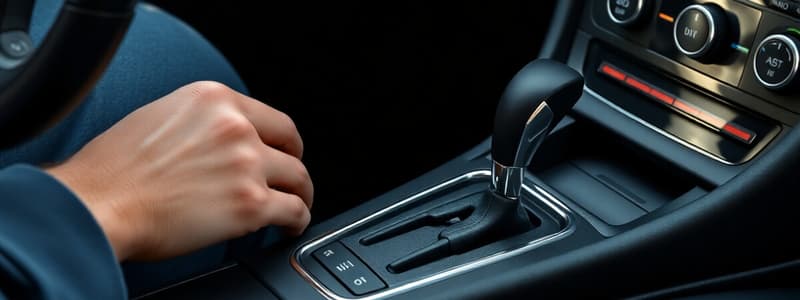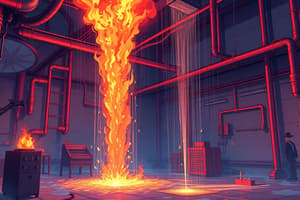Podcast
Questions and Answers
What is the primary purpose of selecting the 'P' position in an automatic gearbox?
What is the primary purpose of selecting the 'P' position in an automatic gearbox?
- To ensure the vehicle is secure when parked. (correct)
- To allow the vehicle to move freely.
- To facilitate towing the vehicle.
- To engage the engine with the drive wheels.
What must be done before shifting the selector from 'P' to 'R'?
What must be done before shifting the selector from 'P' to 'R'?
- Move the car forward slightly.
- Engage the handbrake.
- Depress the footbrake. (correct)
- Turn off the engine.
When is it appropriate to select the 'N' position?
When is it appropriate to select the 'N' position?
- When accelerating quickly to merge onto a highway.
- When towing the vehicle after a breakdown. (correct)
- During temporary stops in traffic.
- When the vehicle is in motion.
What happens when you shift the selector to 'R' without applying the brakes?
What happens when you shift the selector to 'R' without applying the brakes?
What is the function of 'D' in an automatic gearbox?
What is the function of 'D' in an automatic gearbox?
How do modern automatic gearboxes respond to driving styles?
How do modern automatic gearboxes respond to driving styles?
Which of these is a recommended safety practice before starting the engine?
Which of these is a recommended safety practice before starting the engine?
What risk does leaving the selector in 'N' while the vehicle’s wheels are moving pose?
What risk does leaving the selector in 'N' while the vehicle’s wheels are moving pose?
What happens to the vehicle's gearbox when it stops while in 'Drive' mode?
What happens to the vehicle's gearbox when it stops while in 'Drive' mode?
In what situation is it appropriate to engage the reverse gear?
In what situation is it appropriate to engage the reverse gear?
Why is it advised against shifting the gear lever to 'Neutral' when stationary in traffic?
Why is it advised against shifting the gear lever to 'Neutral' when stationary in traffic?
What is the primary purpose of keeping an automatic vehicle in 'Park' when not in use?
What is the primary purpose of keeping an automatic vehicle in 'Park' when not in use?
What is indicated by the selector lever position 'N'?
What is indicated by the selector lever position 'N'?
For situations requiring additional control, what can be beneficial?
For situations requiring additional control, what can be beneficial?
What is the potential hazard of mistakenly using the left foot on the footbrake in an automatic vehicle?
What is the potential hazard of mistakenly using the left foot on the footbrake in an automatic vehicle?
Which statement about shifting gear in automatic vehicles is incorrect?
Which statement about shifting gear in automatic vehicles is incorrect?
What must be done to prevent the vehicle from creeping when selector positions 'P' or 'N' are not selected?
What must be done to prevent the vehicle from creeping when selector positions 'P' or 'N' are not selected?
When coasting in an automatic vehicle, releasing the accelerator pedal will result in which of the following?
When coasting in an automatic vehicle, releasing the accelerator pedal will result in which of the following?
Which is the proper action when parked on a steep hill with an automatic gearbox?
Which is the proper action when parked on a steep hill with an automatic gearbox?
How does the rate of creep behave when the vehicle is on a downhill slope?
How does the rate of creep behave when the vehicle is on a downhill slope?
What does the term 'run on' refer to in the context of automatic vehicles?
What does the term 'run on' refer to in the context of automatic vehicles?
In manual selection mode, how can an emergency response prevent loss of control?
In manual selection mode, how can an emergency response prevent loss of control?
When is it necessary to avoid secondary braking in relation to gear selection?
When is it necessary to avoid secondary braking in relation to gear selection?
What can a driver do to effectively manage the vehicle's behavior when approaching a steep hill in an automatic vehicle?
What can a driver do to effectively manage the vehicle's behavior when approaching a steep hill in an automatic vehicle?
Flashcards are hidden until you start studying
Study Notes
Automatic Gearbox Selector Positions
- Park (P): Selected when the vehicle is parked, before the engine is switched off. Footbrake should be depressed when starting the engine to prevent the vehicle from rolling. Do not move the selector lever to 'P' while the vehicle is in motion.
- Reverse (R): Usually located next to 'Park'. Footbrake should be depressed when moving from 'P' to 'R' or when moving from 'P' to R to get to another selector position. The vehicle may start to move backward immediately after being shifted to 'R'.
- Neutral (N): No power is transmitted from the engine to the drive wheels. Used for towing after a breakdown or accident. Should not be selected for temporary stops in traffic. Consult the vehicle manual before towing, as some systems may be damaged when the lever is left in 'N' while the wheels are moving.
- Drive (D): Regular operation mode for driving under normal conditions. The transmission automatically adjusts according to speed, engine loading, and accelerator position.
- Manual selection (M): Many modern automatic gearboxes have manual selection. In these cases, the selector lever can remain in 'D' for ordinary driving. During response driving, or in situations where additional control is required, selecting a gear manually can be beneficial.
Automatic Gearbox Characteristics
- Creep: When any selector position other than 'P' or 'N' is selected and the footbrake or handbrake is not applied, the vehicle will creep forward or backward at low speed, even without pressing the accelerator pedal.
- Run on: When driving in 'D', releasing the accelerator pedal does not result in downshifting to a lower gear, and engine compression is not apparent. This is referred to as 'run-on' and provides a driving sensation similar to 'coasting'.
- Downhill Driving: The combined effects of run-on and gravity can result in a progressive increase in speed when driving downhill. Steep downward slopes can produce a sensation of losing control as gravity takes over and speed rises sharply.
Studying That Suits You
Use AI to generate personalized quizzes and flashcards to suit your learning preferences.




